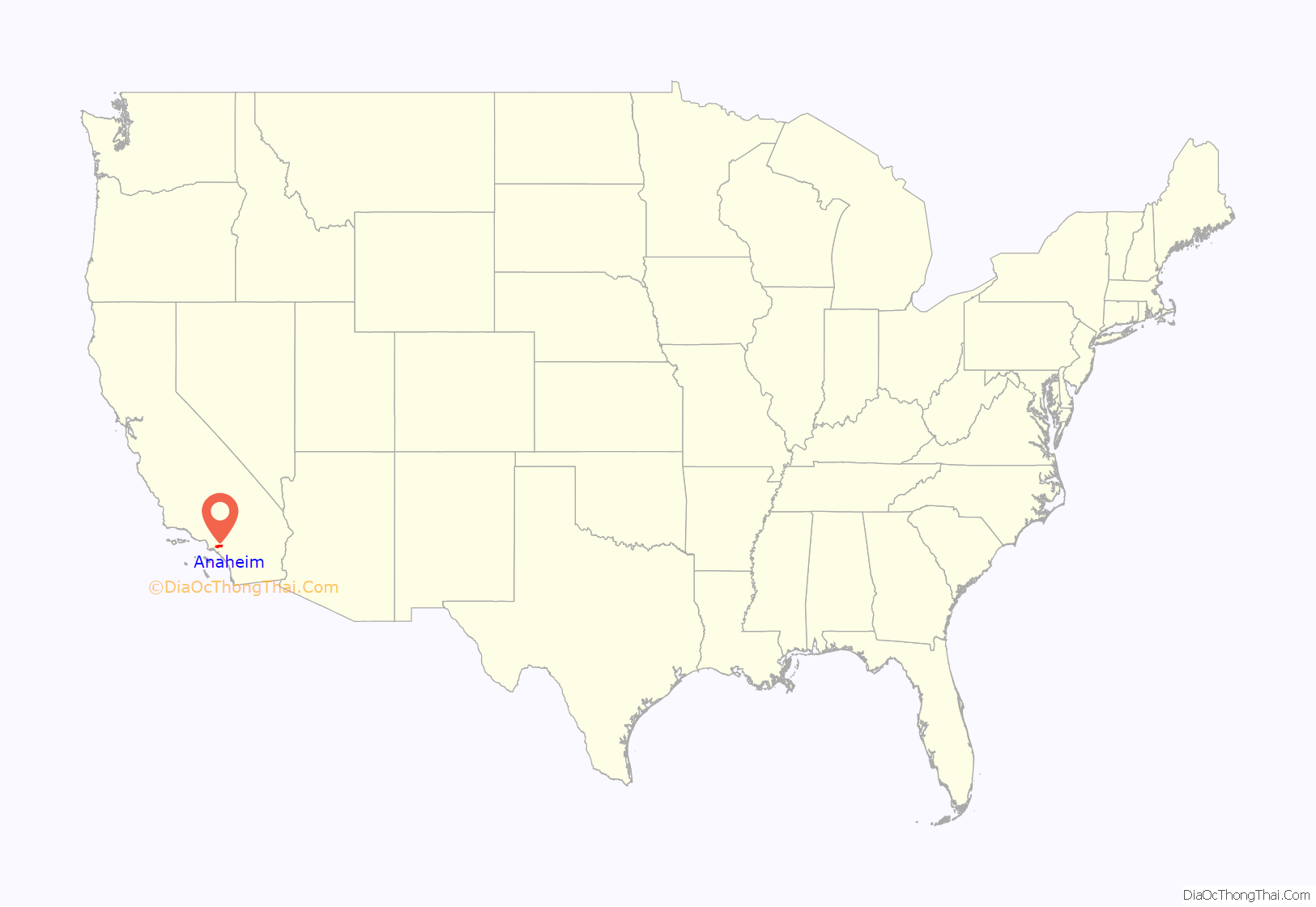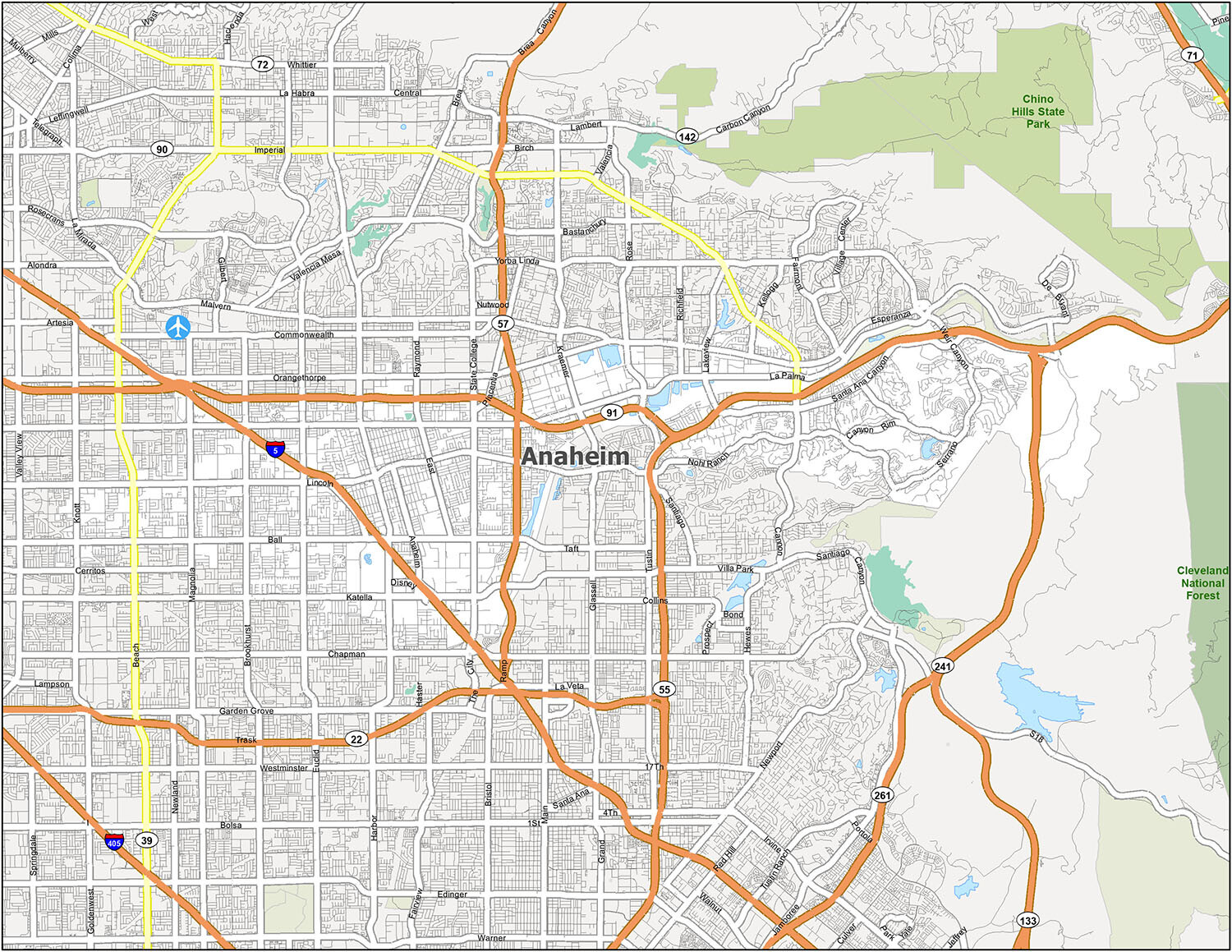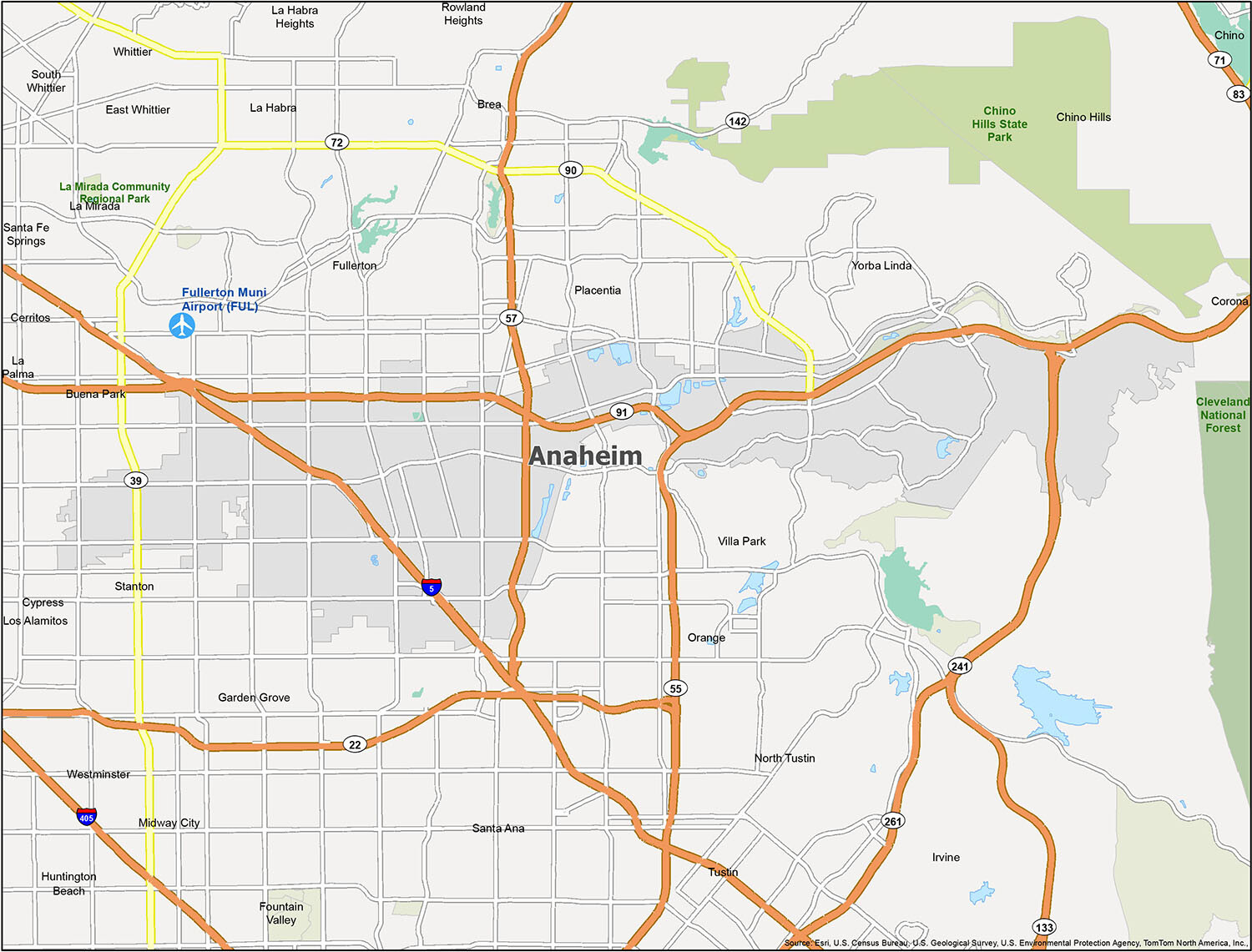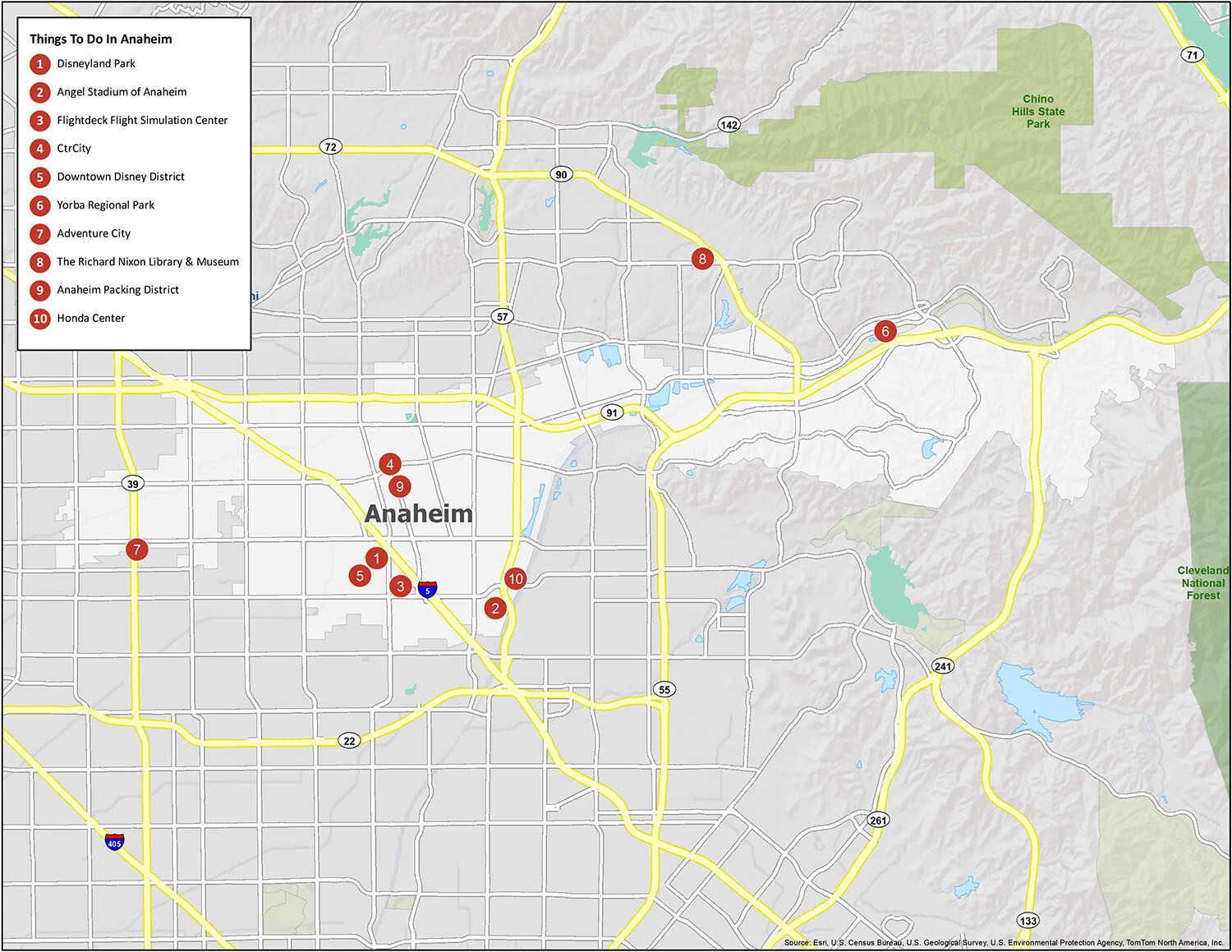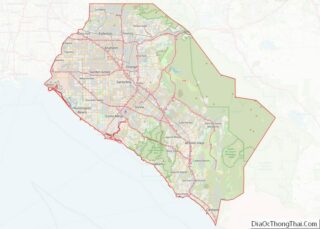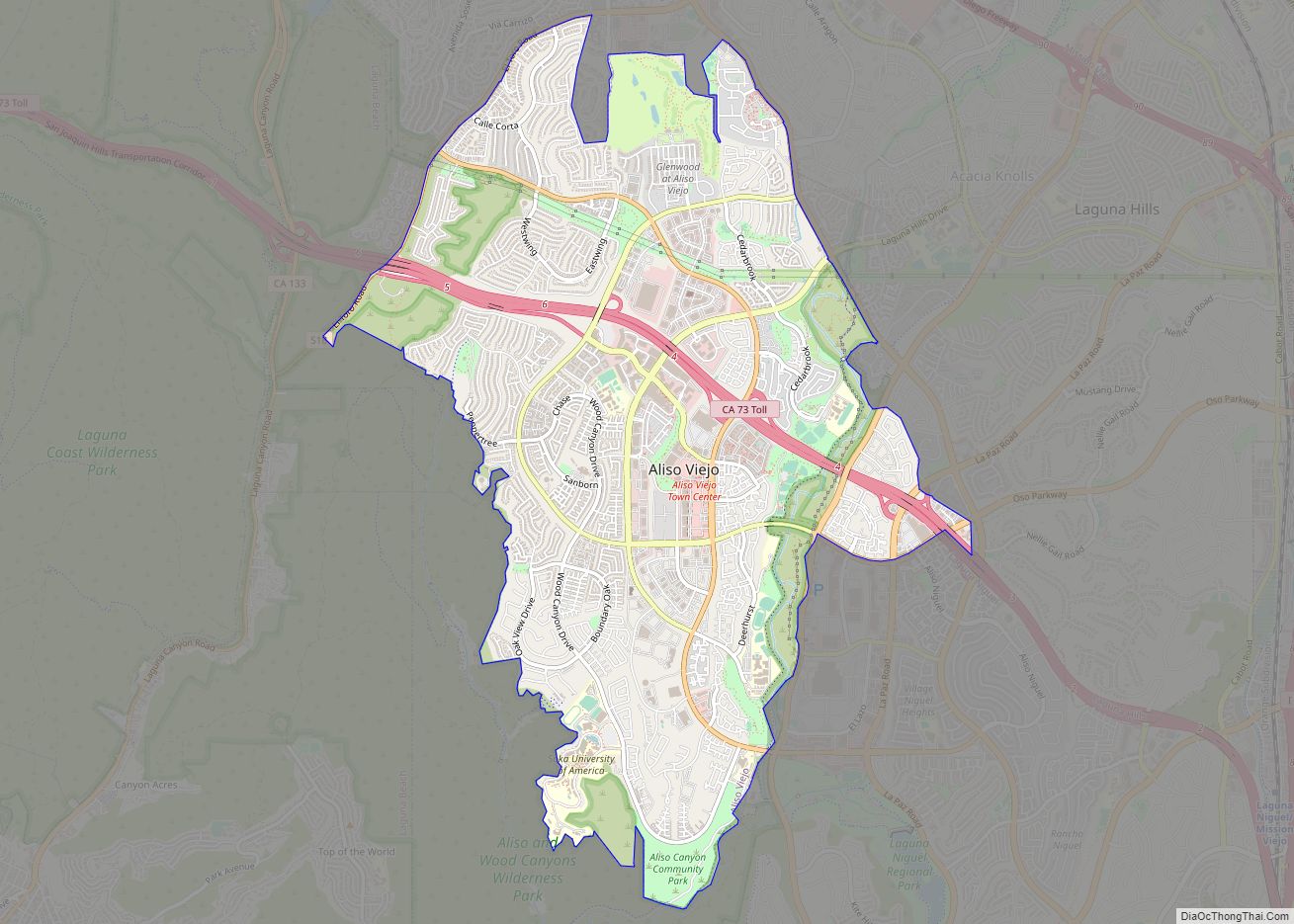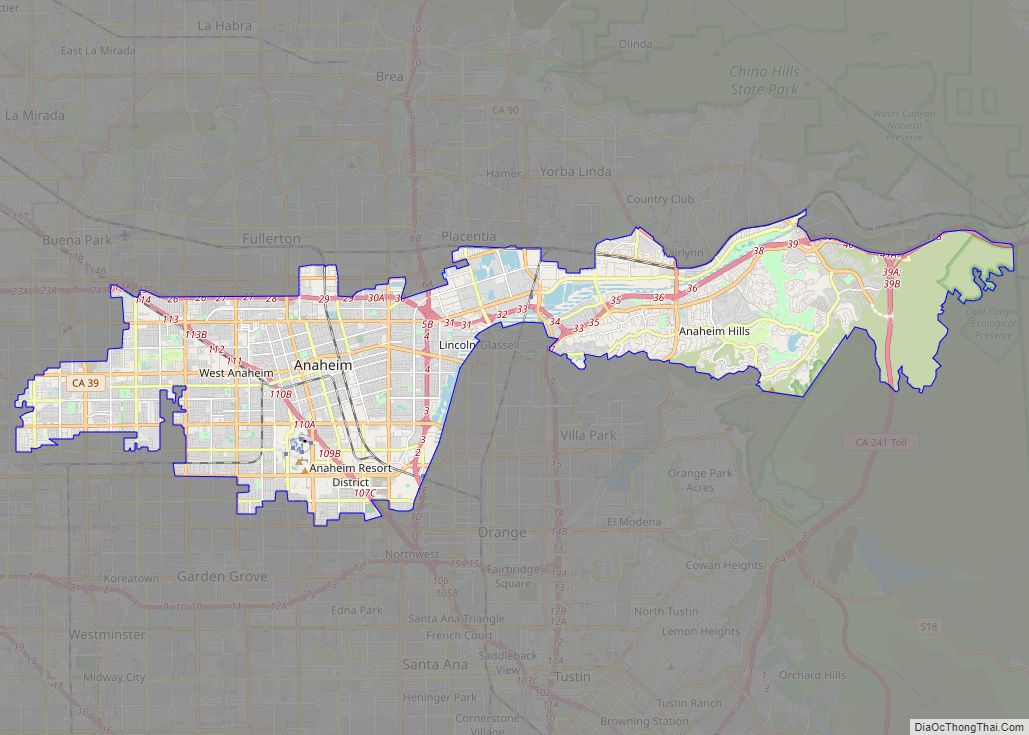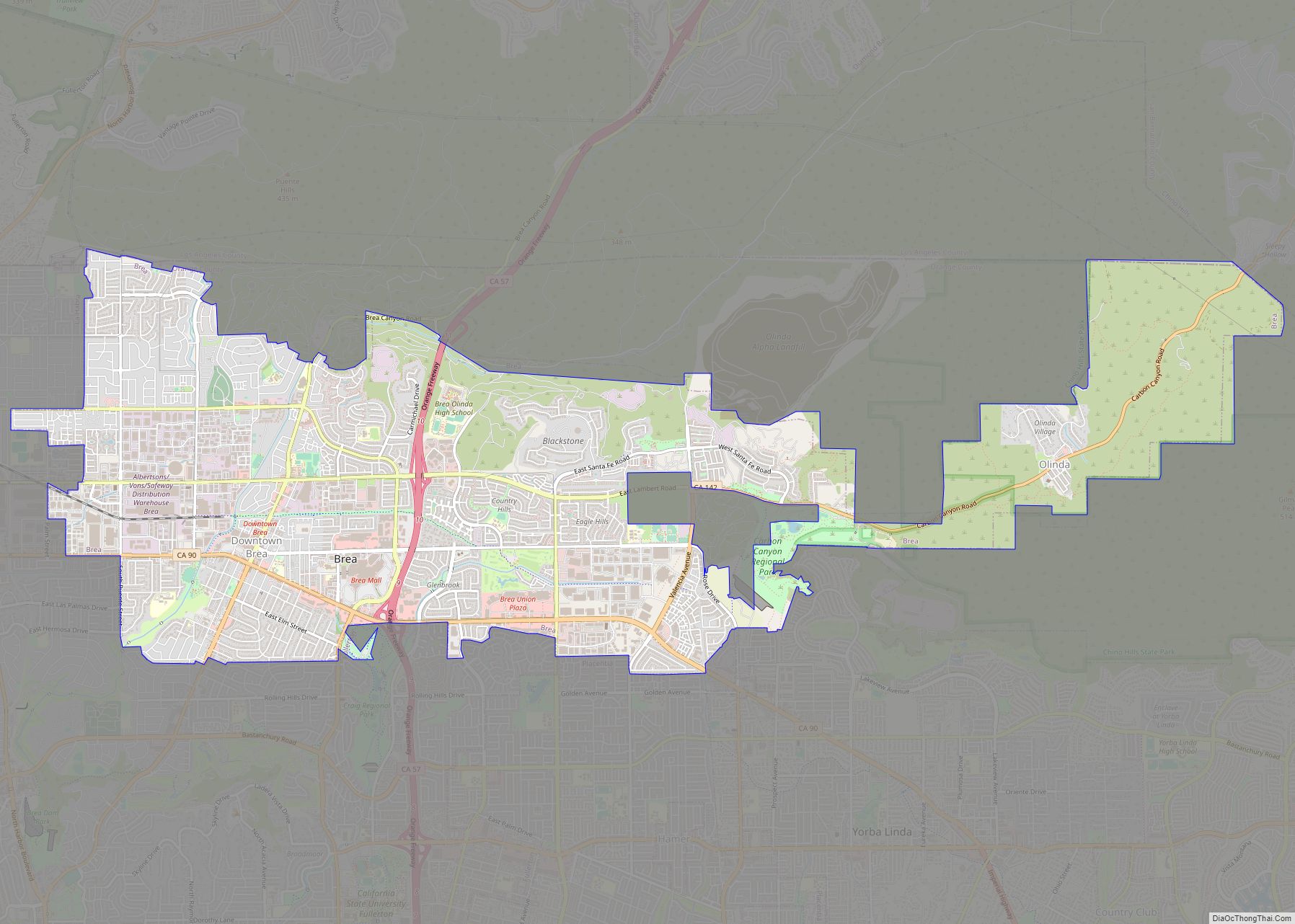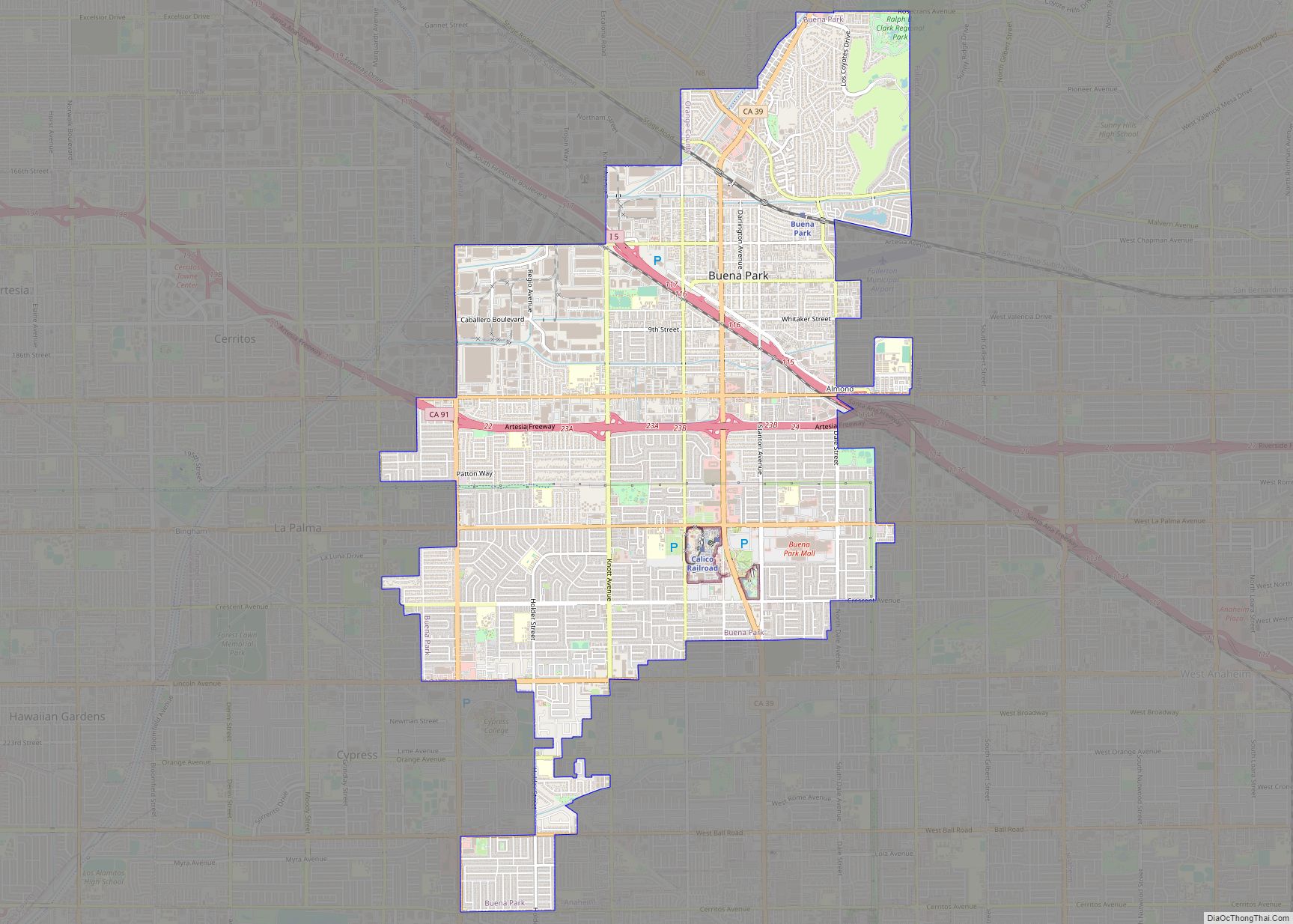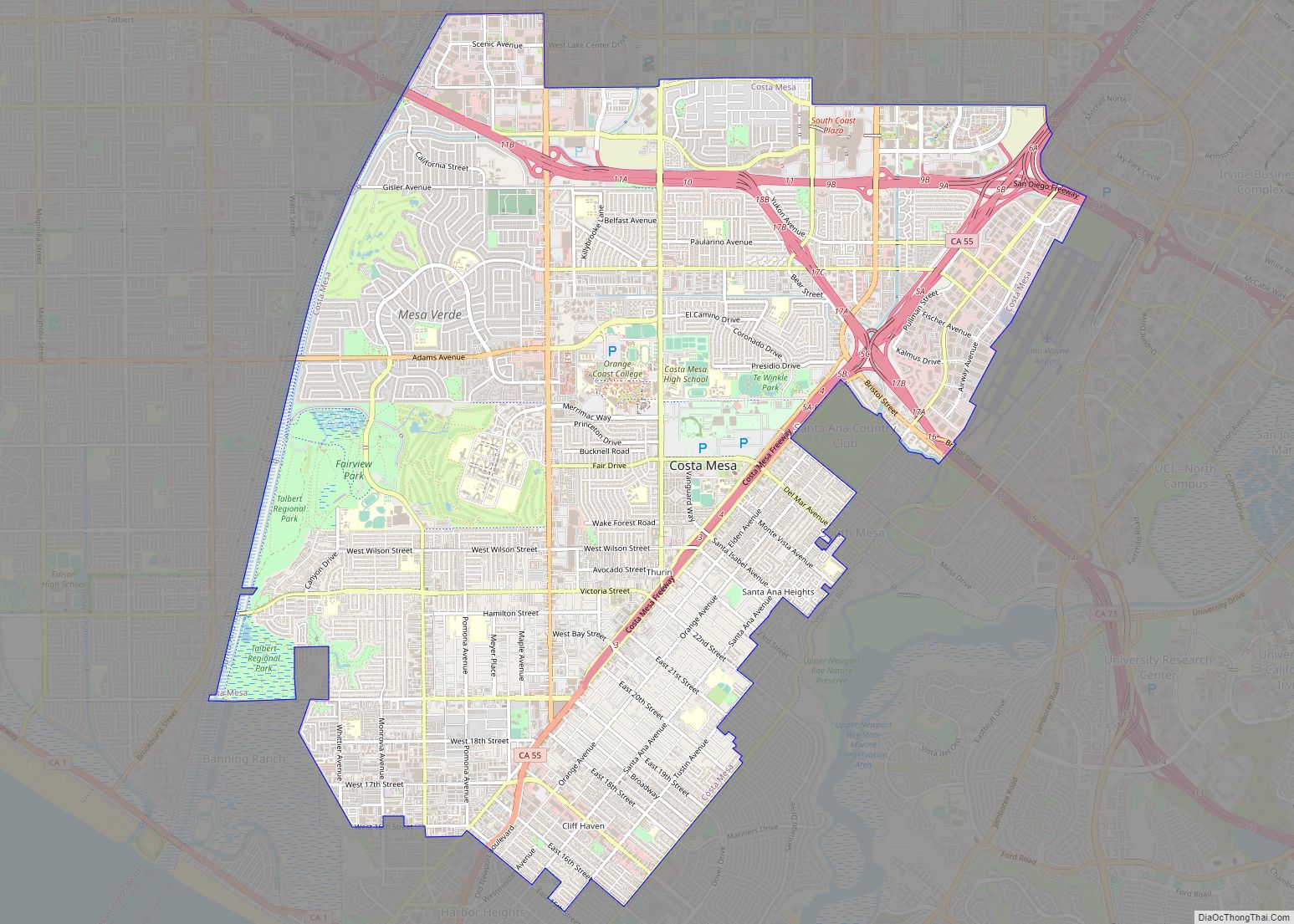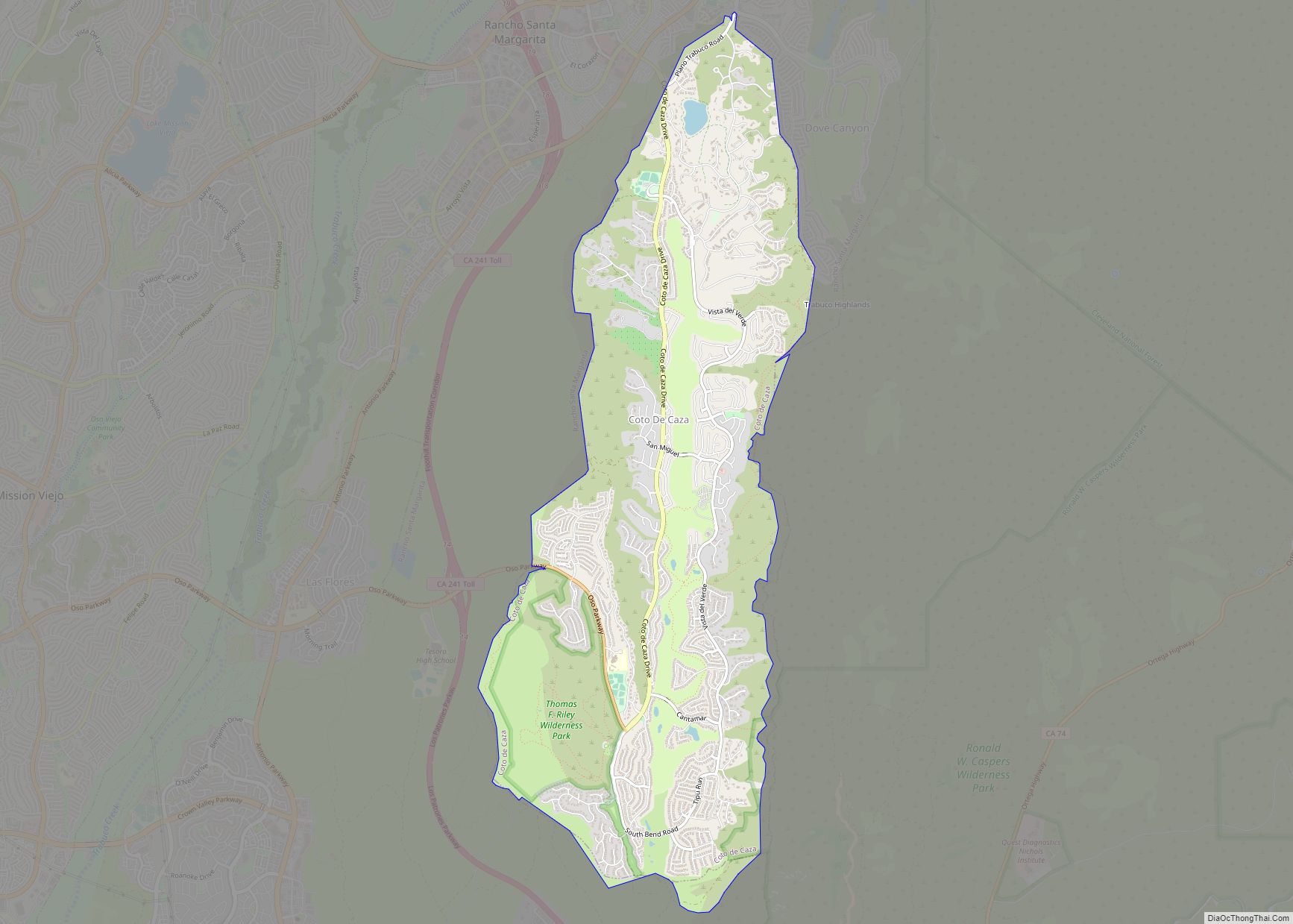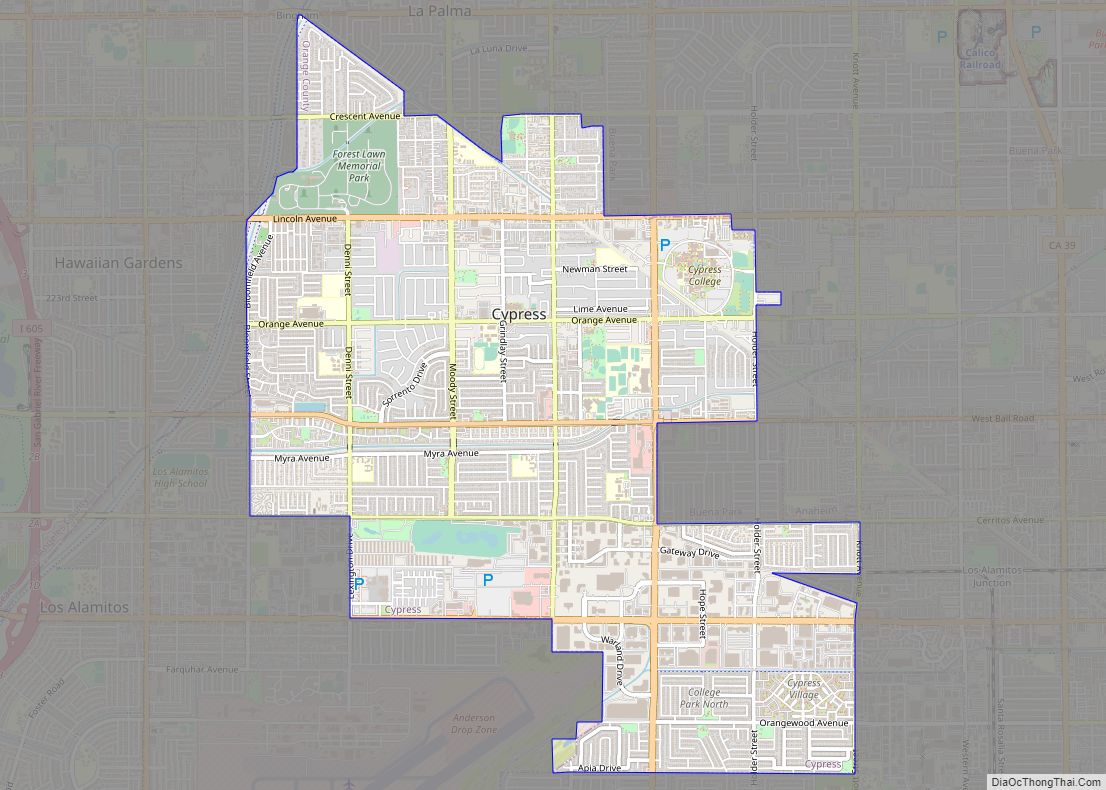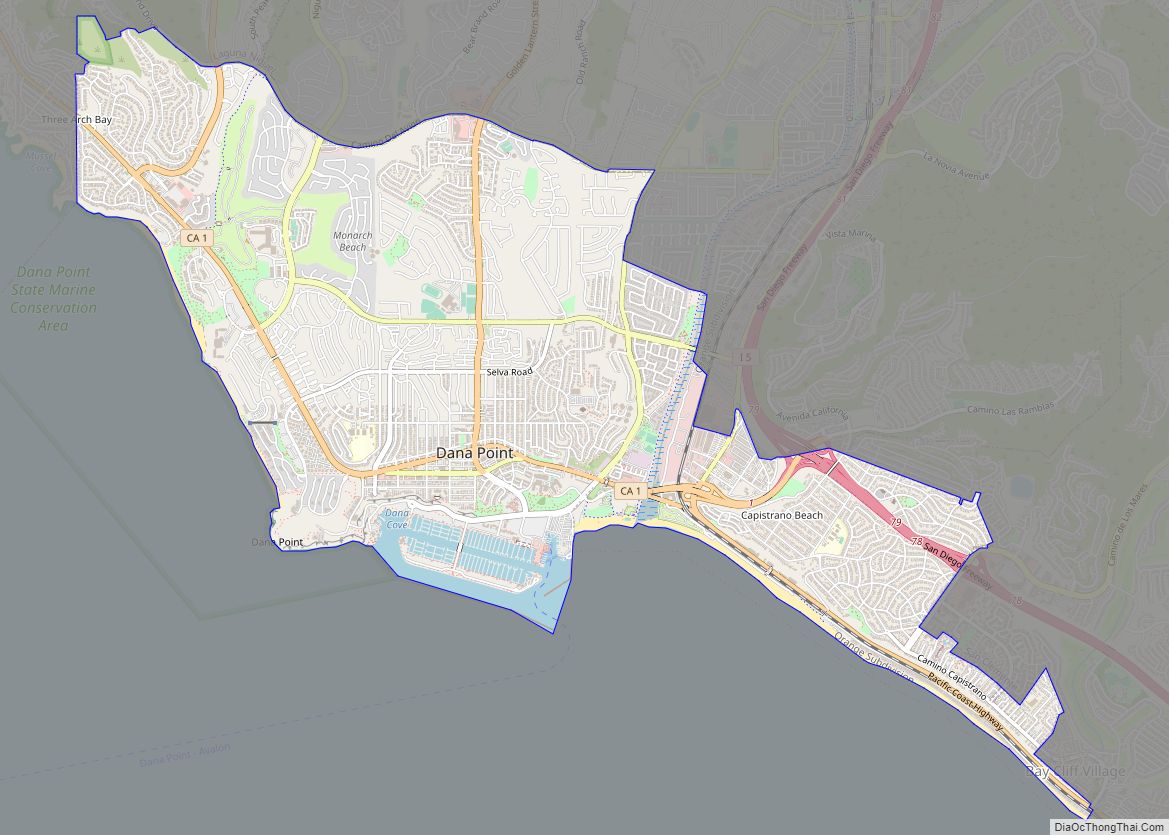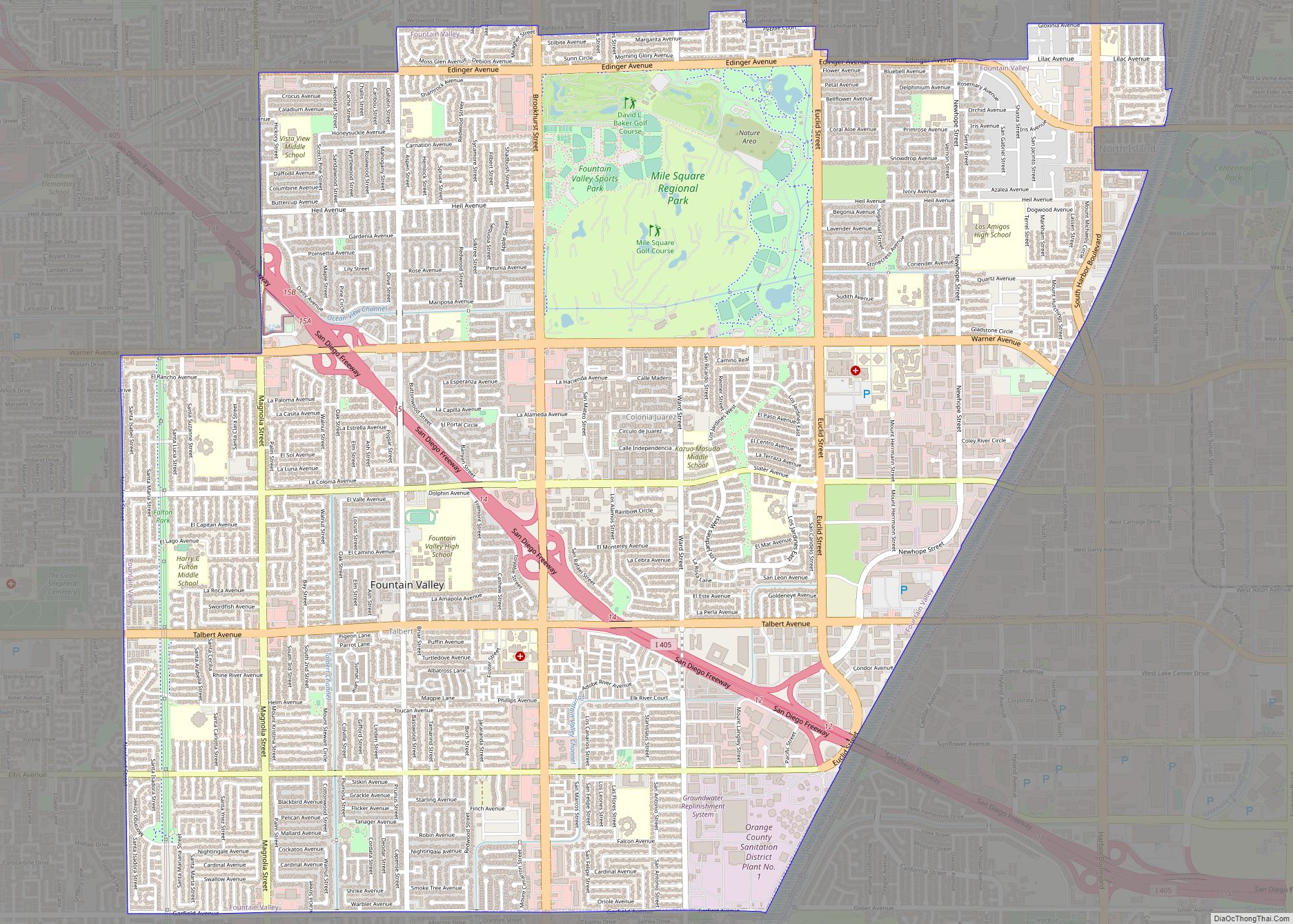Anaheim (/ˈænəhaɪm/ AN-ə-hyme) is a city in northern Orange County, California, part of the Los Angeles metropolitan area. As of the 2020 United States Census, the city had a population of 346,824, making it the most populous city in Orange County, the 10th-most populous city in California, and the 55th-most populous city in the United States. Anaheim is the second-largest city in Orange County in terms of land area, and is known for being the home of the Disneyland Resort, the Anaheim Convention Center, and two major sports teams: the Los Angeles Angels baseball team and the Anaheim Ducks ice hockey club.
Anaheim was founded by fifty German families in 1857 and incorporated as the second city in Los Angeles County on March 18, 1876; Orange County was split off from Los Angeles County in 1889. Anaheim remained largely an agricultural community until Disneyland opened on July 17, 1955. This led to the construction of several hotels and motels around the area, and residential districts in Anaheim soon followed. The city also developed into an industrial center, producing electronics, aircraft parts and canned fruit. Anaheim is a charter city.
Anaheim’s city limits extend almost the full width of Orange County, from Cypress in the west, twenty miles east to the Riverside County line, encompassing a diverse range of neighborhoods. In the west, mid-20th-century tract houses predominate. Downtown Anaheim has three mixed-use historic districts, the largest of which is the Anaheim Colony. South of downtown, a center of commercial activity of regional importance begins, the Anaheim–Santa Ana edge city, which stretches east and south into the cities of Orange, Santa Ana, and Garden Grove. This edge city includes the Disneyland Resort, with two theme parks, multiple hotels, and its retail district; Disney is part of the larger Anaheim Resort district with numerous other hotels and retail complexes. The Platinum Triangle, a neo-urban redevelopment district surrounding Angel Stadium, which is planned to be populated with mixed-use streets and high-rises. Further east, Anaheim Canyon is an industrial district north of the Riverside Freeway and east of the Orange Freeway. The city’s eastern third consists of Anaheim Hills, a community built to a master plan, and open land east of the Route 241 tollway.
| Name: | Anaheim city |
|---|---|
| LSAD Code: | 25 |
| LSAD Description: | city (suffix) |
| State: | California |
| County: | Orange County |
| Founded: | 1857 |
| Incorporated: | March 18, 1876 |
| Elevation: | 157 ft (48 m) |
| Total Area: | 50.88 sq mi (131.78 km²) |
| Land Area: | 50.27 sq mi (130.20 km²) |
| Water Area: | 0.61 sq mi (1.58 km²) |
| Total Population: | 346,824 |
| Population Density: | 6,899.22/sq mi (2,663.78/km²) |
| ZIP code: | 92801–92809, 92812, 92814–92817, 92825, 92850, 92899 |
| FIPS code: | 0602000 |
| Website: | www.anaheim.net |
If you plan on visiting Anaheim, make sure to check out our Anaheim map collection for a road map, list of things to do, and interactive map. The collection also includes our California map, which is available for download. With our map collection, you’ll be able to explore all of the incredible attractions and activities that Anaheim has to offer.
Online Interactive Map
Click on ![]() to view map in "full screen" mode.
to view map in "full screen" mode.
Anaheim is the largest city in Orange County, California. It is located near the Pacific coast of Southern California, about 30 miles south of downtown Los Angeles. It has a total population of over 350,000 people, making it the 10th most populated city in California. In this interactive map of Anaheim, you can explore the city to see what businesses are nearby.
Anaheim location map. Where is Anaheim city?
History
Tongva era
Tongva people are indigenous to Anaheim’s region of Southern California. Evidence suggests their presence since 3500 BCE. The Tongva village at Anaheim was called Hutuukuga. The village has been noted as one of the largest Tongva villages throughout Tovaangar. Native plants like oak trees and sage bushes were an important food source, as well as rabbit and mule deer for meat. The village had deep trade connections with coastal villages and those further inland.
Spanish and Mexican era
The area that makes up modern-day Anaheim, along with Placentia and Fullerton, were part of the Rancho San Juan Cajón de Santa Ana, a Mexican-era rancho grant, given to Juan Pacífico Ontiveros in 1837 by Juan Bautista Alvarado, then Governor of Alta California. Following the American Conquest of California, the rancho was patented to Ontiveros by Public Land Commission. In 1857, Ontiveros sold 1,160 acres (out of his more than 35,000 acre estate) to 50 German-American families for the founding of Anaheim.
Founding
The city of Anaheim was founded in 1857 by 50 German-Americans who were residents of San Francisco and whose families had originated in Rothenburg ob der Tauber, Franconia in Bavaria. After traveling through the state looking for a suitable area to grow grapes, the group decided to purchase a 1,165 acres (4.71 km) parcel from Juan Pacífico Ontiveros’ large Rancho San Juan Cajón de Santa Ana in present-day Orange County for $2 per acre.
For $750 a share, the group formed the Anaheim Vineyard Company headed by George Hansen. Their new community was named Annaheim, meaning “home by the Santa Ana River” in German. The name later was altered to Anaheim. To the Spanish-speaking neighbors, the settlement was known as Campo Alemán (English: German Field).
Although grape and wine-making was their primary objective, the majority of the 50 settlers were mechanics, carpenters and craftsmen with no experience in wine-making. The community set aside 40 acres (16 ha) for a town center and a school was the first building erected there. The first home was built in 1857, the Anaheim Gazette newspaper was established in 1870 and a hotel in 1871. The census of 1870 reported a population of 565 for the Anaheim district. For 25 years, the area was the largest wine producer in California. However, in 1884, a disease infected the grape vines and by the following year the entire industry was destroyed. Other crops – walnuts, lemons and oranges – soon filled the void. Fruits and vegetables had become viable cash crops when the Los Angeles – Orange County region was connected to the continental railroad network in 1887.
Helena Modjeska
Polish actress Helena Modjeska settled in Anaheim with her husband and various friends, among them Henryk Sienkiewicz, Julian Sypniewski and Łucjan Paprocki. While living in Anaheim, Helena Modjeska became good friends with Clementine Langenberger, the second wife of August Langenberger. Helena Street and Clementine Street are named after these two ladies, and the streets are located adjacent to each other as a symbol of the strong friendship which Helena Modjeska and Clementine Lagenberger shared. Modjeska Park in West Anaheim, is also named after Helena Modjeska.
Early 20th century
During the first half of the 20th century, Anaheim was a massive rural community dominated by orange groves and the landowners who farmed them. One of the landowners was Bennett Payne Baxter, who owned much land in northeast Anaheim that today is the location of Angel Stadium. He came up with many new ideas for irrigating orange groves and shared his ideas with other landowners. He was not only successful, he helped other landowners and businesspeople succeed as well. Ben Baxter and other landowners helped to make Anaheim a thriving rural community before the opening of Disneyland transformed the city. A street along Edison Park is named Baxter Street. Also during this time, Rudolph Boysen served as Anaheim’s first Park Superintendent from 1921 to 1950. Boysen created a hybrid berry which Walter Knott later named the boysenberry, after Rudy Boysen. Boysen Park in East Anaheim was also named after him.
In 1924, Ku Klux Klan members were elected to the Anaheim City Council on a platform of political reform. Up until that point, the city had been controlled by a long-standing business and civic elite that was mostly German American. Given their tradition of moderate social drinking, the German Americans did not strongly support prohibition laws of the day. The mayor himself was a former saloon keeper. Led by the minister of the First Christian Church, the Klan represented a rising group of politically oriented non-ethnic Germans who denounced the elite as corrupt, undemocratic, and self-serving. The Klansmen aimed to create what they saw as a model, orderly community, one in which prohibition against alcohol would be strictly enforced. At the time, the KKK had about 1200 members in Orange County. The economic and occupational profile of the pro and anti-Klan groups shows the two were similar and about equally prosperous. Klan members were Protestants, as were the majority of their opponents; however, the opposition to the Klan also included many Catholic Germans. Individuals who joined the Klan had earlier demonstrated a much higher rate of voting and civic activism than did their opponents, and many of the individuals in Orange County who joined the Klan did so out of a sense of civic activism. Upon easily winning the local Anaheim election in April 1924, the Klan representatives promptly fired city employees who were known to be Catholic and replaced them with Klan appointees. The new city council tried to enforce prohibition. After its victory, the Klan chapter held large rallies and initiation ceremonies over the summer.
The opposition to the KKK’s hold on Anaheim politics organized, bribed a Klansman for their secret membership list, and exposed the Klansmen running in the state primaries, defeating most of the candidates. Klan opponents in 1925 took back local government, and succeeded in a special election in recalling the Klansmen who had been elected in April 1924. The Klan in Anaheim quickly collapsed; its newspaper closed after losing a libel suit, and the minister who led the local Klavern moved to Kansas.
Mid to late 20th century: Disneyland and the Anaheim Resort
Construction of the Disneyland theme park began on July 16, 1954, and it opened to the public on July 17, 1955. It has become one of the world’s most visited tourist attractions, with over 650 million visitors since its opening. The location was formerly 160 acres (0.65 km) of orange and walnut trees. The opening of Disneyland created a tourism boom in the Anaheim area. Walt Disney had originally intended to purchase additional land to build accommodations for Disneyland visitors; however, the park’s construction drained his financial resources and he was unable to acquire more land. Entrepreneurs eager to capitalize on Disney’s success moved in and built hotels, restaurants, and shops around Disneyland and eventually boxed in the Disney property, and turned the area surrounding Disneyland into the boulevards of colorful neon signs that Walt Disney had tried to avoid. The city of Anaheim, eager for tax revenue these hotels would generate, did little to obstruct their construction.
By the mid-1960s, the city’s explosive growth would attract a Major League Baseball team, with the California Angels relocating from Los Angeles to Anaheim in 1966, where they have remained since. In 1980, the National Football League’s Los Angeles Rams relocated from the Los Angeles Memorial Coliseum to the Angels’ home field, Anaheim Stadium, playing there until their relocation to St. Louis in 1995. In 1993, Anaheim gained its own National Hockey League team when The Walt Disney Company founded the Mighty Ducks of Anaheim.
In the 1990s, while Disneyland was undergoing a significant expansion project surrounding the construction of Disney California Adventure Park, the city of Anaheim rebranded the surrounding area as the Anaheim Resort. The Anaheim Resort district is roughly bounded by the Santa Ana River to the east, Ball Road to the north, Walnut Street to the west, and the Garden Grove city limits to the south at Chapman Avenue, and Orangewood Avenue to the southwest. Attractions within the Resort District include the Disneyland Resort, the Anaheim Convention Center, the Honda Center, Anaheim/Orange County Walk of Stars, and Angel Stadium of Anaheim.
Part of the project included removing the colorful neon signs and replacing them with shorter, more modest signs, as well as widening the arterial streets in the area into tree-lined boulevards.
21st century
In 2001, Disney’s California Adventure (renamed Disney California Adventure Park in 2010), the most expansive project in Disneyland’s history, opened to the public. In 2007, Anaheim celebrated its sesquicentennial.
In July 2012, political protests by Hispanic residents occurred following the fatal shooting of two men, the first of whom was unarmed. Protesting occurred in the area between State College and East Street, and was motivated by concerns over police brutality, gang activity, domination of the city by commercial interests, and a perceived lack of political representation of Hispanic residents in the city government. The protests were accompanied by looting of businesses and homes.
Anaheim Road Map
Anaheim is a vibrant city located in Orange County, California. It is bordered by the City of Fullerton to the north and Santa Ana to the south. The Sierra Nevada mountains lie to its east and are home to a variety of outdoor activities like camping, hiking, and even snowshoeing. Whether you’re planning a trip to this city or just want to know what’s around, a comprehensive Anaheim map can provide you with helpful information about the city and its surrounding areas. This road guide, along with our California road map, will be your go-to for all your travel needs.
Anaheim, California is a vibrant and diverse city, with a multitude of neighborhoods and cultures. Whether you’re visiting or relocating here, be sure to utilize our Anaheim map for useful information about this California hub. There are also numerous museums and cultural institutions to explore, offering a great way to learn more about different cultures and spend quality time with family members from other countries.
10 things to do in Anaheim city
Anaheim is a city full of fun and entertainment! From Disneyland and Downtown Disney to Yorba Regional Park and the Richard Nixon Library and Museum, there is something for everyone to enjoy. Plus, there are plenty of restaurants to choose from, as well as sports teams to cheer on. Whether you’re looking for a family-friendly day out or a night out on the town, Anaheim has it all.
Anaheim city Satellite Map
Geography
Anaheim is located at 33°50′10″N 117°53′23″W / 33.836165°N 117.889769°W / 33.836165; -117.889769 and is approximately 25 miles (40 km) southeast of downtown Los Angeles. The city roughly follows the east-to-west route of the 91 Freeway from the Orange-Riverside county border to Buena Park. To the north, Anaheim is bounded by Yorba Linda, Placentia, Fullerton, and Buena Park (from east to west). The city shares its western border with Buena Park and Cypress. Anaheim is bordered on the south by Stanton, Garden Grove, and Orange (from west to east). Various unincorporated areas of Orange County also abut the city, including Anaheim Island. According to the United States Census Bureau, the city has a total area of 50.8 square miles (132 km), 49.8 square miles (129 km) of which is land and 1.0 square mile (2.6 km) of which (1.92%) is water.
Cityscape
The city recognizes several districts, including the Anaheim Resort (the area surrounding Disneyland), Anaheim Canyon (an industrial area north of California State Route 91 and east of California State Route 57), and the Platinum Triangle (the area surrounding Angel Stadium). Anaheim Hills also maintains a distinct identity. The contiguous commercial development from the Disney Resort through into the cities of Orange, Garden Grove and Santa Ana has collectively been termed the Anaheim–Santa Ana edge city.
Climate
Like many other South Coast cities, Anaheim maintains a borderline hot semi-arid climate (Köppen BSh), a little short of a Mediterranean climate (Köppen Csa) characterized by warm winters with erratic heavy rainfalls, and hot, essentially rainless summers. The record high temperature in Anaheim is 115 °F (46 °C) on July 6, 2018 and the record low temperature is 30 °F (−1 °C) on February 15, 1990, and January 30, 2002.
See also
Map of California State and its subdivision:- Alameda
- Alpine
- Amador
- Butte
- Calaveras
- Colusa
- Contra Costa
- Del Norte
- El Dorado
- Fresno
- Glenn
- Humboldt
- Imperial
- Inyo
- Kern
- Kings
- Lake
- Lassen
- Los Angeles
- Madera
- Marin
- Mariposa
- Mendocino
- Merced
- Modoc
- Mono
- Monterey
- Napa
- Nevada
- Orange
- Placer
- Plumas
- Riverside
- Sacramento
- San Benito
- San Bernardino
- San Diego
- San Francisco
- San Joaquin
- San Luis Obispo
- San Mateo
- Santa Barbara
- Santa Clara
- Santa Cruz
- Shasta
- Sierra
- Siskiyou
- Solano
- Sonoma
- Stanislaus
- Sutter
- Tehama
- Trinity
- Tulare
- Tuolumne
- Ventura
- Yolo
- Yuba
- Alabama
- Alaska
- Arizona
- Arkansas
- California
- Colorado
- Connecticut
- Delaware
- District of Columbia
- Florida
- Georgia
- Hawaii
- Idaho
- Illinois
- Indiana
- Iowa
- Kansas
- Kentucky
- Louisiana
- Maine
- Maryland
- Massachusetts
- Michigan
- Minnesota
- Mississippi
- Missouri
- Montana
- Nebraska
- Nevada
- New Hampshire
- New Jersey
- New Mexico
- New York
- North Carolina
- North Dakota
- Ohio
- Oklahoma
- Oregon
- Pennsylvania
- Rhode Island
- South Carolina
- South Dakota
- Tennessee
- Texas
- Utah
- Vermont
- Virginia
- Washington
- West Virginia
- Wisconsin
- Wyoming
